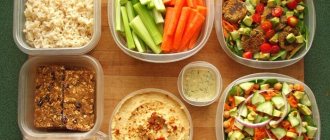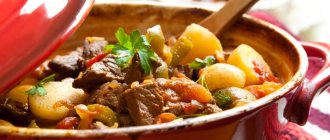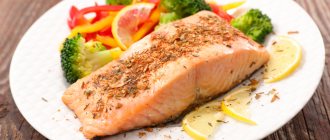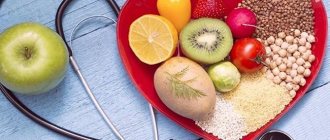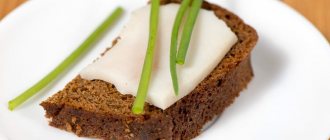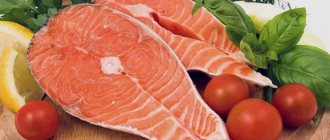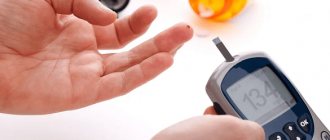The text is for informational purposes only. We strongly urge you not to use diets, resort to any therapeutic menus or fasting without medical supervision. We recommend reading: “Why you can’t go on a diet on your own.” Nutrition for hemorrhoids is an important component of proctological treatment, aimed at reducing intra-abdominal pressure on the rectum. If you adjust your diet in the first stages of the disease, you can achieve long-term remission, and in some cases, complete recovery. In addition, diet therapy increases the effectiveness of traditional treatment (for severe forms of pathology) and prevents the appearance of new nodes (in the postoperative period).
General information
Hemorrhoids are a disease of the rectum, characterized by pathological expansion of the veins in the anus.
The first signs of the disease are blood during bowel movements, itching in the anus, pain during bowel movements. The main cause of the disorder is an increase in intra-abdominal pressure and pressure in the vessels of the rectum.
Factors contributing to blood stagnation in the veins of the anus:
- straining during bowel movements;
- sedentary lifestyle;
- lifting weights;
- dehydration of the body;
- straining during childbirth;
- acute hypovitaminosis;
- diseases of the pelvic organs (cystitis, prostatitis);
- severe cough syndrome (with bronchial asthma).
- prolonged “standing” on your feet.
- alcohol abuse.
Content:
- General information
- Principles of nutrition
- List of permitted products
- Prohibited Products
- Nutrition after surgery
- Sea buckthorn will restore intestinal health
- Menu for hemorrhoids
- Conclusion
In most cases, this disease develops gradually without the presence of pronounced symptoms. Initially, a person feels slight discomfort in the anus (during bowel movement). At this stage, hemorrhoids may fall out, but are easily reduced (on their own).
As the disease progresses, pain during bowel movements increases, which is accompanied by minor bleeding from the anus. In this case, hemorrhoidal “bumps” fall out not only during emptying, but also with the slightest physical effort. In the absence of proper therapy, the disease is fraught with severe complications (necrosis, thrombosis, paraproctitis, cryptitis).
At the last stage of the disease, it is possible to get rid of the nodes only with surgical intervention, since they are constantly on the outside and cannot be corrected on their own.
general information
The occurrence of the inflammatory process of hemorrhoidal veins is often triggered by poor nutrition. A large number of harmful products increase the flow of blood to the pelvic organs, which causes overflow of the venous system and the appearance of hemorrhoids. Anyone who is faced with such a delicate disease is forced not only to take medications prescribed by the doctor, but also to follow a special diet.
Proper nutrition in such a situation is necessary to prevent constipation, because in case of hemorrhoids, bowel dysfunction aggravates the course of the disease.
Principles of nutrition
The main objectives of the “antihemorrhoidal” diet are to restore impaired intestinal functions (eliminate constipation or diarrhea), normalize blood flow in the pelvic organs, and increase vascular elasticity.
General principles of nutrition:
- Maintain drinking regime. Considering that the density of stool depends on the amount of liquid consumed, it is important to consume at least 2 liters of water per day to thin the stool. With insufficient water intake, the transit of chyme through the intestines slows down. This leads to compaction of feces and damage to the veins of the anal canal (from bowel movements).
To combat constipation (especially long-term constipation), drink a third of the daily volume of water on an empty stomach (in 1-1.5 hours). The remaining portion of liquid is consumed throughout the day (in small sips).
- Enrich your daily diet with fiber. Dietary fiber is the basis of dietary nutrition for hemorrhoids. Fiber helps increase the volume of stool and smooth bowel movements. Along with this, pectins have an astringent, enveloping and protective effect on the digestive tract.
Remember, the diet of people suffering from hemorrhoids should consist of 50-*% plant fiber.
- Eliminate alcohol from the daily menu. Alcoholic drinks dehydrate the patient's body, promoting dehydration of water from the intestines. In case of hemorrhoidal disease, it is permissible to consume alcohol only during the period of remission (in minimal doses).
- Follow a fractional diet. The optimal frequency of meals is 6 times a day. Preference should be given to liquid crushed foods: pureed soups, fermented milk products, boiled porridges, fruit smoothies. A fractional diet is indicated in the acute and postoperative period (to reduce pressure on the intestinal walls during bowel movements).
- Chew food thoroughly. This will prevent large food particles from entering the gastrointestinal tract; unchewed food particles can damage the mucous lining of the large intestine. For good digestion, chew solid foods 30-40 times.
- Consume food in small portions, no more than 250 grams. A dosed diet will help relieve the gastrointestinal tract, and, as a result, reduce pressure on the walls of the anal canal.
- Control the temperature of food. For cracks or prolapses of the intestine, it is important to consume warm food (15-60 degrees). Cold or hot foods irritate the walls of the organ, worsening its evacuation function.
Remember, to maintain intestinal tone, it is important to combine a healthy diet with moderate physical activity (excluding heavy lifting).
Among the preferred sports are: swimming, gymnastics, tennis, race walking, jogging, roller skating, skiing, and skating. They improve blood supply in the pelvic area, train the cardiovascular system, and eliminate peripheral edema. In addition, these sports improve the body’s physical performance and strengthen the immune system, which in turn prevents the development of hemorrhoids.
Reviews and results
The reviews and results of following this therapeutic diet are only positive and its effectiveness is appreciated by many. The diet is easy to implement in everyday life. Everyone notes that it is easily tolerated and the main thing is not to overload the gastrointestinal tract with an abundance of fatty and difficult to digest food, but to focus on vegetable dishes and fruits.
- “... I have been suffering from constipation and hemorrhoids for many years. With age, the problem worsened - a crack appeared. With a rectal fissure, dietary nutrition is very important. Koda did not attach any importance to this; the crack worsened every month, and terrible pain bothered me. I began to carefully monitor my diet, drink a lot of water (sometimes forcefully), and this helped me. Prunes, pumpkin porridge and beets help me well. I noticed that you need to eat this way all the time, otherwise constipation returns, and when you strain, hemorrhoids worsen”;
- “... I suffer from constipation and this disease, I used laxative suppositories for a long time, and then I realized that you can get used to them and you need to watch your diet. I noticed that bread, buns, potatoes and pasta make me sick, and after eating like this for a week, constipation and aggravation immediately occur. Diet and drinking plenty of water helps a lot - you can improve your bowel movements in just 5 days. I even lost weight in a month by eliminating all flour and potatoes. Now I’m friends with beets and seaweed”;
- “... On this diet, normal stool is quickly restored. At night I always drink kefir with bran, and during the day I eat up to 6 prunes. I also do special exercises every day. I try to follow a diet, even while on business trips. I can say that there has been no exacerbation of hemorrhoids for 2 years, and all thanks to nutrition.”
List of permitted products
To reduce the risk of developing or exacerbating the disease, the diet should consist of 50% of foods that improve intestinal function.
For rectal pathologies, consume the following foods:
- Vegetables. To improve stool, the daily menu is enriched with products that have a mild laxative effect: beets, cucumbers, carrots, zucchini, cabbage, pumpkin. Intake of starchy vegetables (potatoes, radishes, radishes) is kept to a minimum (as they cause constipation). Plant foods are consumed fresh, boiled or baked.
- Dairy products. Persons suffering from hemorrhoids are recommended to enrich their daily diet with the following products: kefir, yogurt, fermented baked milk, yogurt. These drinks supply the body with beneficial flora, stimulate the evacuation function, accelerate the movement of the food bolus through the intestines, and promote the healing of anal fissures.
- Cereals. The following porridges will help reduce the load on the digestive system: buckwheat, pearl barley, oatmeal, wheat, barley. It is better to avoid consuming semolina and rice cereals (as they have a fixing effect).
- Fruits. To prevent and treat constipation, patients’ daily diet includes bananas, apricots, apples, plums, pears, peaches, strawberries, oranges, figs, dried apricots, raisins, and prunes. When choosing a fruit, give preference to ripe fruits, since unripe fruits irritate the intestinal walls.
- Bread. Due to the high gluten content, products made from white flour are “banned.” To improve intestinal functions, it is recommended to consume whole grain baked goods and breads.
- Greenery. Plant tops, thanks to the high concentration of vitamin C and rutin, have a venotonic and anti-inflammatory effect on the intestinal walls. In addition, greens supply the body with iron, which is necessary for the synthesis of red blood cells (especially for bleeding from hemorrhoids).
- Vegetable oils. Envelops the intestinal walls, stimulates painless bowel movements, and heals anal fissures. The most useful oils are pumpkin, sea buckthorn, olive, flaxseed, and cedar. For persistent constipation, take the product twice a day (30 minutes before breakfast and 60 minutes before bedtime). However, for gallstones, oils are used with caution because they stimulate bile secretion.
Prohibited Products
Diet therapy for hemorrhoids involves excluding from the menu foods that stimulate blood flow to the vessels, irritate the rectal mucosa, and increase gas formation in the digestive tract.
List of prohibited products:
- pastries, puff pastry products, white flour bread;
- white sugar;
- wheat pasta (white);
- fried foods;
- hot spices (mustard, pepper, horseradish);
- semolina and rice porridge;
- fatty meats;
- alcohol;
- coffee, black tea, carbonated drinks;
- potatoes, radishes, radishes, onions, garlic, beans, peas;
- confectionery;
- whole milk, cream;
- animal fats;
- rich broths;
- quince, blueberry, barberry;
- canned food, marinades, pickles, smoked meats.
In addition, when nodes fall out, it is important to monitor the amount of salt consumed, since its excess provokes an exacerbation of the disease. The optimal portion of salt is 7 grams per day.
Remember, consuming prohibited foods is only permissible during the period of remission (in limited quantities). Therapeutic nutrition in the acute phase of the disease should be more strict.
Absolute prohibitions
The diet for external hemorrhoids, like the diet for hemorrhoids with blood, does not allow the consumption of foods that increase gas formation and slow down intestinal function. Therefore, you should try to adhere to a diet that excludes:
- blueberries, quince, barberry;
- bananas, potatoes, onions, legumes, garlic, mushrooms;
- hard-boiled and fried eggs;
- pasta;
- cream cakes, pastries, chocolate products;
- canned, smoked foods and pickles;
- semolina, rice
Also, people with hemorrhoids need to exclude baked goods, pastries, and puff pastry dishes. When preparing dishes, it is recommended to reduce the use of salt, black and red pepper and other seasonings.
By knowing which foods to remove from your diet, you can get rid of hemorrhoids and its symptoms much faster.
Find out what you can’t eat if you have hemorrhoids, what foods are on the list of prohibited or undesirable foods, in our author’s material.
Nutrition after surgery
Elective surgery is indicated for people with severe forms of the disease when conservative treatment does not produce positive results. After removal of hemorrhoids, the recovery period lasts 1-1.5 months. During this time, it is important to adhere to a gentle diet (so as not to injure the intestinal wall with coarse food particles). In addition, for successful scar healing, bowel movements should be avoided in the first 24 hours after hemorrhoidectomy (procedure to remove nodes). In view of this, the daily diet consists of only drinking plenty of fluids (water, green tea, herbal decoctions). On the second day, it is permissible to include dietary food in the patient’s menu.
List of products for the “first week” after surgery:
- vegetable puree soups (ground);
- liquid porridge cooked in water (buckwheat or oatmeal);
- steamed meatballs (from lean meats);
- low-fat fermented milk products (mashed cottage cheese, kefir).
A week later, baked fruits, stewed vegetables, boiled fish and meat are added to the patients’ menu.
The main principles of postoperative nutrition (in the first month):
- Maintain drinking regime. To avoid the risk of relapse, the daily menu must contain at least 2 liters of water.
- Consume food every 2 hours. Eating six meals a day “facilitates” the process of defecation, “providing” a soft consistency to the stool.
- Take food in small doses. To reduce the load on the intestinal tract, the serving size should not exceed 160 grams.
- Use gentle food processing methods. In the first month after hemorrhoidectomy, food is consumed only in boiled, baked or steamed form (to eliminate the possibility of damage to the intestines by solid particles).
- Balance the daily menu. To normalize stool, the diet includes at least 60% carbohydrates, 30% fats, 15% proteins.
Remember, disorderly eating after surgery can lead to complications: scar infection, rupture of sutures, bleeding from the anus.
What should you not eat for 30 days after surgery?
During the recovery period, foods that cause flatulence and fermentation are “banned.”
List of prohibited products:
- Fresh berries, vegetables, fruits (especially apples, radishes, cabbage, grapes, turnips, garlic, raspberries).
- Legumes (beans, peas, lentils).
- Whole milk.
- Bakery and confectionery products (including those made from whole grain flour).
- Spices, spices.
- Nuts (especially peanuts, almonds, hazelnuts).
- Carbonated drinks (lemonade, kvass, mineral water).
- Alcohol.
- Black tea, coffee.
- Canned food, marinades, smoked meats, pickles.
- Fatty meats (pork, lamb, duck, goose).
- Mushrooms.
If these rules are followed, the wound will heal completely within a month of diet therapy. Along with this, intestinal motility is restored, the tone of the veins in the anus is normalized, and digestion is improved. To speed up the healing of damaged tissue, you can use bactericidal sitz baths (sage, calendula or chamomile).
Effective treatment
To eliminate bleeding, the doctor may prescribe anti-inflammatory suppositories with adrenaline for rectal use.
To strengthen blood vessels, improve blood circulation in the nodes and increase capillary tone, he will definitely recommend a phlebotropic drug. For example, detralex, venoruton, venarus.
To normalize bowel movements and digestion, drugs are used: mucofalk, laminarid, duphalac, etc.
| Heavy bleeding | Suppositories with adrenaline, hemostatic drugs: adroxon, tachocomb or spongostan, dicinone, sodium etamisylate, aminocaproic acid. |
| For conservative treatment | Phlebotonic drugs Detralex, Phlebodia600, Venarus, Glivenon, Venoruton. |
| Pain syndrome | Non-narcotic analgesics: analgin, baralgin, painkillers in the form of gels, ointments and suppositories: nefluan, aurobin, ultraproct, posterizan-forte, proctoglivenol, posterisan, etc. |
| Prolonged bleeding | Sclerotherapy (injection with the drug) is used into the affected nodes. |
If there are traces of thrombosis on the hemorrhoids, direct anticoagulants are used.
Doctor's supervision is important! Even after successful treatment and bleeding cessation, you should see a doctor. The specialist will indicate further recommendations and adjust the diet.
THERE ARE CONTRAINDICATIONS CONSULTATION WITH YOUR DOCTOR IS REQUIRED
Author of the article Alexey Alexandrovich Egorov, proctologist
Write your opinion
Sea buckthorn will restore intestinal health
Sea buckthorn oil is an effective remedy for the prevention and relief of hemorrhoids, used in both folk and traditional medicine. The usefulness of this product is due to the presence of a large number of venotonic substances in the composition.
The main components of sea buckthorn oil:
- Vitamins (, , ,). They strengthen the capillaries of the anus, stimulate the regeneration of injured areas of the epithelium, accelerate the healing of postoperative scars, improve the tone of the vascular bed, increase the elasticity of the walls of the anus, and prevent the appearance of new hemorrhoids (due to increased collagen synthesis).
- Tannins (phytoncides, pectins, serotonin, alkaloids, coumarins). They reduce swelling of hemorrhoids, relieve pain in the anus, and eliminate bleeding from the anus.
- Unsaturated fatty acids (palmitic, linoleic, oleic, linolenic, palmitoleic). They improve the rheological characteristics of blood and prevent its stagnation in the pelvic veins.
- Organic acids (malic, oxalic, succinic, tartaric). They reduce the intensity of the inflammatory process, accelerate the healing of anal fissures, and eliminate irritation in the anus.
Sea buckthorn oil is used to treat the disease at all stages of the pathology (including the acute phase).
During the period of remission, the product is used internally in its pure form (to prevent the formation of new nodes). Dosage regimen: 15 milliliters 2 times a day: in the morning (after waking up) and in the evening (before bedtime). The duration of oil therapy is 60 days.
In case of exacerbation of hemorrhoidal disease, it is advisable to combine oral and local administration of an oil solution. To reduce the inflammatory process, oil is applied to the “bumps” at least 5 times a day (on gauze pads). The treatment dressing exposure time is 1 hour. For internal hemorrhoids, the composition is injected into the rectum using a turunda or microenema.
How to make your own sea buckthorn oil?
To obtain a composition enriched with fat-soluble vitamins, it is better to use berries of a rich red-orange color.
Cooking diagram:
- Prepare the berries for processing: rinse, remove branches.
- Squeeze juice from fresh fruits.
- Dry the sea buckthorn cake in the oven (at a temperature not exceeding 40 degrees).
- Grind the dry pomace in a coffee grinder.
- Divide the resulting mixture into 3 parts.
- Pour the first portion of the cake with sunflower oil (refined). Ratio 1:5.
- Infuse the resulting composition for three days in a warm place (stirring 2 times a day).
- Strain the three-day oil through a fine sieve and discard the first cake.
- Add the second part of the dry cake to the “primary” oil. Leave for 3 days.
- Repeat the procedure with a third portion of sea buckthorn.
Pour the finished mixture into a glass container and store in the refrigerator.
Types of disease
There are two types of hemorrhoids - internal and external. The internal one affects the nodes that are located at the end of the rectum, and the external one affects the nodes on the mucous membrane of the anus from the outside. The two types of pathology have different clinical presentations and treatment methods. Most often, hemorrhoids occur in people in a chronic form and the patient is periodically bothered by exacerbations.
They can be caused by a number of unfavorable factors, but regardless of the provoking cause, the pathology requires immediate action. Typically, the disease occurs in people over 30 years of age, and women are more susceptible to developing hemorrhoids.
The clicking sound that occurs in the joints during the movement of the skeleton has become a common phenomenon; such a sound is also formed when trying to crack your fingers. The habit of intentionally “crunching” can cause irritation among others; many believe that such manipulations are harmful. Read more in the article: “what happens if you crack your fingers.”
Menu for hemorrhoids
Diet therapy for diseases in the anal area is aimed at normalizing the functioning of the digestive tract, in particular preventing constipation and diarrhea.
Monday
After waking up: 300 ml of water.
Breakfast: 100 g oatmeal, 50 g bananas, 20 g walnuts, 10 g rye toast.
Lunch: 150 ml cabbage, 70 g steam cutlets, 10 ml sea buckthorn oil.
Afternoon snack: 100 g of curd mass, 50 g of cranberries, 20 ml of thermostatic sour cream.
Dinner: 100 g barley porridge, 70 g pike perch (boiled), 50 g mixed greens.
An hour before bedtime: 150 ml of 1% fermented baked milk.
Tuesday
An hour before the 1st meal: 700 ml of water (in 3-4 doses).
Breakfast: 100 g of buckwheat porridge (preferably green), 60 g of cucumber salad, 10 g of bran.
Lunch: 100 g apple-banana smoothie.
Lunch: 150 g of vegetable puree (beets, zucchini, broccoli, carrots), 70 g of steamed meatballs, 20 g of whole grain bread.
Afternoon snack: 150 g fruit cocktail (banana, strawberries, prunes), 20 ml honey.
Dinner: 170 g shrimp-avocado salad, 20 ml pumpkin oil.
An hour before bedtime: 170 g of “young” kefir (one or two days old).
Wednesday
After waking up: 300 ml of clean water.
Breakfast: 100 g egg omelet, 50 g fresh tomatoes, 30 g fresh herbs (dill, cilantro, lettuce).
Lunch: 100 ml fruit jelly, 100 g biscuits.
Lunch: 150 ml fish soup, 100 g vegetable stew (carrots, broccoli, zucchini).
Afternoon snack: 150 ml calendula tea, 100 g pumpkin pancakes (steamed), 20 ml honey.
Dinner: 100 g of wheat porridge, 70 g of lemon-beetroot salad, 15 ml of pumpkin oil.
An hour before bedtime: 150 ml of green smoothie (cilantro, yogurt, salad).
Thursday
40 minutes before breakfast: 800 ml of water (in 3-4 doses).
Breakfast: 150 g of oatmeal, 50 g of seasonal berries (strawberries, blueberries, mulberries), 20 ml of sea buckthorn oil.
Lunch: 200 ml fruit and curd smoothie.
Lunch: 150 ml of green borscht (lean), 70 g of carrot salad, 50 g of turkey (boiled), 15 g of bread.
Afternoon snack: 150 ml knotweed tea, 100 g apple pie.
Dinner: 150 g pumpkin stuffed with buckwheat, 50 g prunes.
An hour before bedtime: 150 ml of yogurt.
Friday
After waking up: 300 ml of water.
Breakfast: 100 g pearl barley porridge, 50 g prunes.
Lunch: 150 ml sage tea, 100 g apple-carrot casserole (with whole grain flour).
Lunch: 150 ml of soup with meatballs, 70 g of stewed cabbage, 10 ml of olive oil.
Afternoon snack: 150 g of sliced fruit (peach, banana, apple), 30 g of whole grain toast.
Dinner: 150 g of Greek salad (tomatoes, cheese, olives, cucumbers, olive oil), 70 g of hake cutlets (boiled).
An hour before bedtime: 200 ml of yoghurt-beetroot mix.
Saturday
After waking up: 300 ml of water.
First meal: 150 ml of knotweed tea, 100 g of Dutch cheese, 30 g of rye bread (dried), 15 g of butter.
Second breakfast: 150 ml apple compote, 70 g pumpkin casserole.
Lunch: 100 g of tomato puree soup (from fresh tomatoes), 100 g of fish steak, 20 ml of sour cream.
Afternoon snack: 150 g of dried fruits (figs, dried apricots, prunes), 50 ml of yogurt.
Dinner: 100 g vegetable stew, 100 g squash caviar (homemade), 15 ml sea buckthorn oil.
An hour before bedtime: 150 ml of low-fat yogurt.
Sunday
After waking up: 350 ml of clean water (passed through a filter).
First meal: 150 ml of herbal tea (sage, dandelion, yarrow), 150 g of oat pancakes (steamed), 20 ml of honey.
Second breakfast: 100 g of apple and Jerusalem artichoke salad.
Lunch: 150 g broccoli puree, 70 g turkey steak (steam), 30 g fresh herbs.
Afternoon snack: 150 g apple cheese salad, 20 ml sea buckthorn oil, 15 g bread (rye).
Dinner: 100 g beet-carrot caviar, 50 g baked potato, 15 ml pumpkin oil.
An hour before bedtime: 200 ml of yoghurt mousse with prunes.
Example of a daily diet
The daily diet for men and women is slightly different. Below are examples of daily menus.
For men
Breakfast: chicory, 2 soft-boiled eggs, buckwheat.
Lunch: salad with tomatoes and mozzarella, boiled potatoes with butter and herbs.
Lunch: pumpkin soup with cream, rice porridge with stewed turkey, tea.
Afternoon snack: cottage cheese casserole with raisins.
Dinner: fish meatballs, stew, compote.
Late dinner: ryazhenka.
Sample menu for men.
For women
Breakfast: oatmeal, yogurt, fruit salad.
Lunch: pumpkin porridge with milk.
Lunch: carrot soup, fish stewed with vegetables, buckwheat porridge, herbal tea.
Afternoon snack: cottage cheese casserole, compote.
Dinner: stew, chicken cutlets, a few slices of bread.
Late dinner: homemade yogurt.
Possible menu for women.
